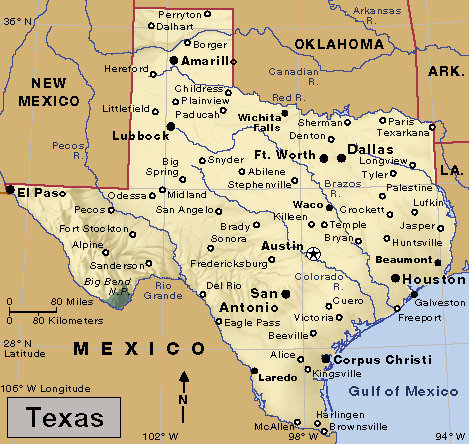Corpus Christi << KAWR puhs KRIHS tee >>, Texas (pop. 317,863; met. area pop. 445,763), is a major United States seaport and a center of industry and tourism. It lies on Corpus Christi Bay, near the Gulf of Mexico. The city was named for the bay. Corpus Christi has a council-manager government.

Description.
Corpus Christi, the county seat of Nueces County, covers about 490 square miles (1,270 square kilometers). This area includes about 330 square miles (855 square kilometers) of inland water. About 65 percent of the people of Corpus Christi are of Hispanic ancestry.
Corpus Christi has a mild climate and attracts many tourists and conventions. Temperatures in the city average 57 °F (14 °C) in January and 84 °F (29 °C) in July. For the monthly weather in Corpus Christi, see Texas (Climate). The city has fine facilities for fishing, sailing, and swimming, and crowds of tourists visit nearby Padre Island National Seashore.
Cultural attractions in Corpus Christi include the Texas State Aquarium, the Art Museum of South Texas, the Corpus Christi Museum of Science and History, and the Texas State Museum of Asian Cultures & Education Center. The city also has a symphony orchestra and a campus of Texas A&M University.
Oceangoing ships reach the Port of Corpus Christi via a 21-mile (34-kilometer) channel that links the city with the Gulf of Mexico. The port, one of the nation’s largest, serves barges that use the Gulf Intracoastal Waterway, which runs along the coastline between Brownsville, Texas, and Carrabelle, Florida. Airlines use Corpus Christi International Airport.
Corpus Christi lies near natural gas and petroleum fields, cattle ranches, and fertile farmland. The city’s chief manufactures include chemicals, petroleum products, and processed foods. The Corpus Christi Army Depot is one of the city’s largest industrial employers.
History.
Karankawa Indians lived in what is now the Corpus Christi area before white settlers arrived. About 1839, a trading post opened at the site to serve nearby ranchers. The settlement was named Corpus Christi probably in 1847 or 1848 and was incorporated as a city in 1852. In 1923, the city developed its first natural gas well. The city’s deepwater port opened in 1926. Oil was discovered nearby in 1930. From 1920 to 1940, the city’s population rose from 10,552 to 57,301.
Naval Air Station Corpus Christi opened in 1941 and trained 40,000 naval fliers during World War II (1939-1945). Today, it is headquarters for the Naval Air Training Command. The area’s large supplies of natural gas and petroleum have attracted many industries to Corpus Christi. The population of the city grew to 167,690 by 1960 and to 307,863 by 2020. A project that improved the port’s capability to handle larger ships was completed in 1989.
